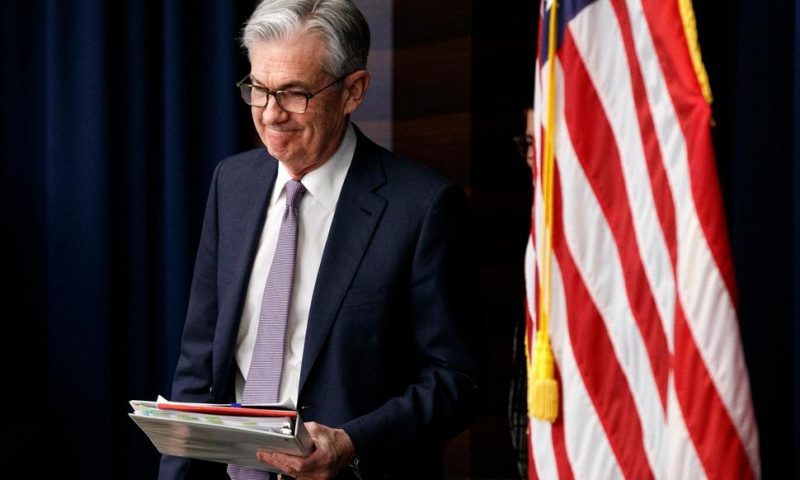For the first time in years, Federal Reserve officials will hold their latest policy meeting this week feeling broadly satisfied with where interest rates are and with seemingly no inclination to change them anytime soon.
WASHINGTON — For the first time in years, Federal Reserve officials will hold their latest policy meeting this week feeling broadly satisfied with where interest rates are and with seemingly no inclination to change them anytime soon.
Chairman Jerome Powell has expressed a sense of gratification with Fed policy, thanks to a steady if unspectacular economy driven by a robust job market. The unemployment rate is at a 50-year low. Economic growth remains solid if modest at a roughly 2% annual rate. With inflation low, the Fed could potentially stand pat for months.
Yet even with the Fed seemingly comfortable with the range of its benchmark rate — a historically low 1.5% to 1.75% — questions about its policy-making remain. They include what the next steps might be for the Fed’s ongoing purchases of short-term Treasury bills, which are intended to keep overnight lending markets free-flowing and to hold down short-term borrowing rates. Officials will also likely spend time at their Tuesday-Wednesday meeting discussing their ongoing review of how the Fed should adapt its policies for a persistently low-inflation, low-interest rate environment.
There is also continued uncertainty about the global economy, concern about high levels of corporate debt and potential risks to the financial markets from consistently ultra-low rates
Last year, the Fed cut its benchmark interest rate three times after having raised it four times in 2018. Powell and other Fed officials credit those rate cuts with revitalizing the housing market, which had stumbled early last year, and offsetting some of the drag from President Donald Trump’s trade war with China.
Among other benefits, the rate cuts have helped drive down mortgage rates and led home buyers to bid up prices on a dwindling number of available properties. Home sales jumped in December and were nearly 11% higher than a year earlier. Since they last met in December, Fed officials have presented a nearly unified front in support of keeping rates unchanged, possibly for the rest of this year. That contrasts with last year, when both “hawks,” who tend to favor higher rates, and “doves,” who typically lean toward lower rates, occasionally dissented from the Fed’s rate decisions.
“My expectation is we could go through the entire year without rate changes,” Charles Evans, president of the Federal Reserve Bank of Chicago, said this month.
Among the policymakers, Evans is regarded as mainly dovish. But his comments were echoed by more hawkish policymakers, such as Patrick Harker, president of the Philadelphia Fed.
Krishna Guha, an analyst at investment bank Evercore/ISI, noted that Fed officials had said in December that rates would remain unchanged “for a time,” according to the minutes of the meeting. That phrasing, which was new, was “an early contender for the understatement of the decade,” Guha wrote.
Economic projections that the Fed released after its most recent meeting in mid-December showed that officials collectively expected to leave rates unchanged throughout this year and to raise them once in 2021 and once in 2022. And Powell indicated at his news conference last month that the bar is high for any rate increases. The chairman said he “would want to see … a significant move-up in inflation that’s also persistent before raising rates to address inflation concerns.”
Most analysts think the Fed would be more willing to cut rates if there were clear signs of a sharp economic slowdown. Still, some Fed watchers say they foresee a rate cut by the summer or after November’s elections.
One reason is that inflation remains chronically low. According to the Fed’s preferred inflation gauge, prices rose just 1.5% in November from a year earlier, below the central bank’s 2% annual target. Since the Fed adopted that target in 2012, inflation has failed to consistently reach that high for reasons that have mystified the Fed and most economists.
That trend has led the central bank to rethink some of its fundamental tools and strategies. With its key short-term rate also very low, officials last year launched a public review of its policy framework. Its main concern is that, should a recession arrive, the Fed would now have little room to cut rates to help stimulate the economy.
Central banks in Europe and Japan are confronting similar challenges. Christine Lagarde, president of the European Central Bank, said last week that the ECB would also launch its own policy review this year.
Should the Fed eventually cut its benchmark rate to nearly zero and still feel it needed to stimulate the economy, officials have said they would start buying Treasurys to try to lower longer-term rates. This is an approach they first used in the aftermath of the Great Recession.
In October, the Fed also started purchasing $60 billion a month in Treasury bills to provide more cash to short-term lending markets. That extra liquidity helps keep the Fed’s benchmark rate in its target range.
The purchases were intended to keep overnight rates from spiking at the end of last year, when many analysts feared that larger banks, rather than lend, would hoard cash to meet regulatory requirements. That fear didn’t come to pass. Still, many economists expect Powell to say at his news conference Wednesday that the Fed will maintain its Treasury purchases through April.
The Fed’s policy-making committee includes Powell and four other governors based in Washington, as well as the 12 presidents of the central bank’s district banks. Only five of those presidents have a vote on interest rate changes at any one time.
The New York Fed president, John Williams, holds a permanent vote. The remaining four votes rotate annually. The new voters at next week’s meeting will be Harker and Presidents Robert Kaplan of the Dallas Fed, Neel Kashkari of the Minneapolis Fed and Loretta Mester of the Cleveland Fed.

